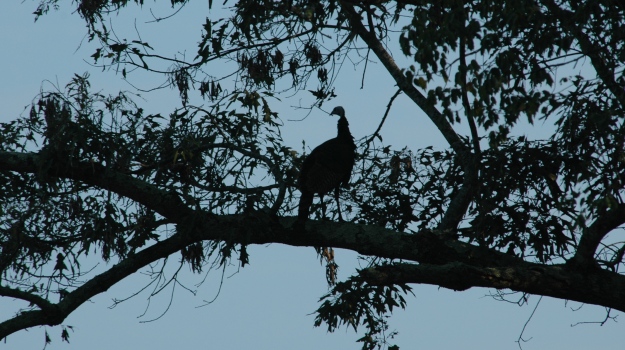Don't Hunt Close to the Roost Tree of Rio Grande Turkeys
with Kevin Burleson

Editor’s Note: Kevin Burleson, one of Mossy Oak’s THUGs, guides at Heart of Texas Bowhunting near Brady, Texas – both bow and shotgun hunters – for turkeys each spring. In Texas, hunters can hunt and take Rio Grande gobblers. If you’ve been hunting eastern wild turkeys all your life, you’ll think you’ve died and gone to heaven, if you have the opportunity to hunt Rio Grandes on a ranch that has plenty of birds like Heart of Texas Bowhunting does. We’ve asked Kevin to tell us some of the major differences between hunting eastern gobblers and Rio Grande turkeys.
When you’re hunting turkeys in the East, your dream every morning is to find one or maybe two turkeys that are gobbling that you can hunt. But in the West, the Rio Grande gobblers usually roost in the same area every night during the spring. For instance, in some of the creek bottoms that we hunt, there may be two or three major roosting sites with Rio Grande gobblers possibly roosting together. This past year we photographed 11 gobblers in full strut at the same time, that had roosted in the same tree. All these gobblers were strutting on the limbs of the tree at the same time. Often we may have as many as 24 or 25 gobblers in one roost tree, and they’ll all be gobbling before daylight. An eastern turkey hunter will be much like a little boy who’s gone quail hunting for the first time and steps right in a covey of 10 to 15 quail, and they all fly in several directions. When the Rio Grande gobblers pitch out of a tree, generally they’ll all go in different directions. Seeing 10 to 20 gobblers in one tree with some of them strutting before daylight is a sight that most eastern turkey hunters rarely, if ever, will see.
 Another thing that makes the Rio Grande toms of the West and Midwest different, even during the breeding season, is you may see three or four gobblers traveling together. When you’re hunting eastern wild turkeys, you rarely, if ever, see several gobblers coming in together. On my game camera that I’ve had looking at a feeder, I’ve got a picture of 32 longbeards together all under one feeder, feeding. All these gobblers were 2-years old or older.
Another thing that makes the Rio Grande toms of the West and Midwest different, even during the breeding season, is you may see three or four gobblers traveling together. When you’re hunting eastern wild turkeys, you rarely, if ever, see several gobblers coming in together. On my game camera that I’ve had looking at a feeder, I’ve got a picture of 32 longbeards together all under one feeder, feeding. All these gobblers were 2-years old or older.
Usually, in the East, as you get closer to the roost tree, the better your odds are for bagging a gobbling turkey. But here in the West, we tend to stay much farther away from roost trees than eastern hunters do. Most of the time, when Rio Grande gobblers are on the roost, they’ll fly down with some of their hens. So, we don’t have very good luck when we’re hunting close to a roost. Generally, we set-up to call and take our turkeys 500- to 600-yards away from the roost tree. When Rio Grandes fly down from the roost, they already know where they’re going. They’ve made their minds up where they want to land, and what cattle or deer trail they want to walk down to get from where they are to where they want to be. Because I live on the property year-round, I know just about every trail the turkeys will walk, when they fly off the roost. So, we’ll set-up along one of those trails and wait on gobblers to come down the trails. Hunting those trails is much more dependable with Rios than taking a stand close to the roost tree. Also, if you get too close to the roost tree and shoot a Rio, you can spook the birds, and they won’t want to come back to that roost tree. They’ll change locations.
Kevin Burleson Says You Can Hunt Rio Grande Gobblers All Day






























